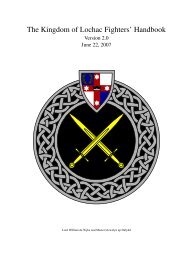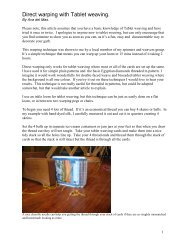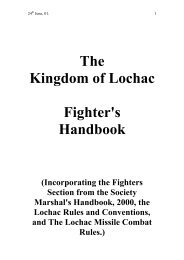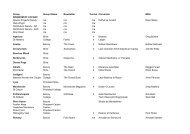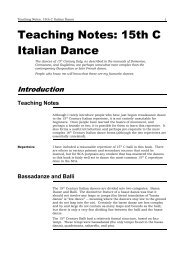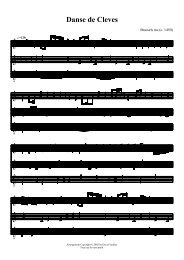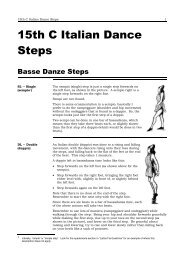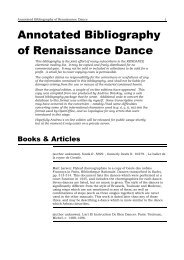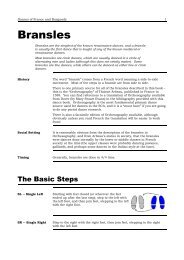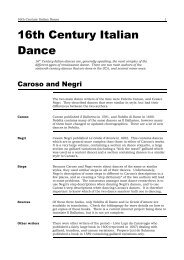15th Century Italian Dance
15th Century Italian Dance
15th Century Italian Dance
You also want an ePaper? Increase the reach of your titles
YUMPU automatically turns print PDFs into web optimized ePapers that Google loves.
<strong>15th</strong> <strong>Century</strong> <strong>Italian</strong> <strong>Dance</strong> 9Bassa DanzeThe earliest <strong>Italian</strong> dance manuscripts are amongst the oldest primarysources of basse danses (or bassa danze, as the <strong>Italian</strong>s called them).Domenico, the earliest <strong>Italian</strong> dance master wrote a book in 1450containing a number of basse danze. He was replaced in the 1455 - 1500period by two of his students, Antonio Cornazano, and Guglielmo Ebreo.Cornazano wrote one fairly extensive text, which contains a number ofdances in a similar style to (or copied from) Domenico. Guglielmo Ebreowrote a much larger number (8, possibly more), smaller texts, of which thefirst one (fonds it. 973) is considered the main source, with the smallervolumes containing mostly dances extracted from it, or alterations todances contained in it.Guglielmo also wrote a manuscript under the name of "GiovanniAmbrosio". It has only recently been established that the two people(Guglielmo and Ambrosio) were the same, and it was thought for a longtime that Ambrosio's work was a plagiarism of Guglielmo's. The confusionwas partially caused by Guglielmo moving to Florence, changing his name,and converting from Judaism to Christianity at the same time. 4By Guglielmo's time as a dance master, the basse danze was starting todie out, and was being replaced (in Italy) by balli (elsewhere in Europe itwas being replaced by the Pavane). The earliest manuscripts (Domenico,Cornazano) list more basse danze than balli, and the balli that they do listare quite simple. Guglielmo lists at least as many balli as basse danze,and by the time of Cesare Negri and Caroso (1580 - 1620), the basse danzehad disappeared, to be replaced by a number of quite complex balli,containing long and difficult step sequences.Even the earliest basse danze in Italy were meant as much forperformance in front of an audience (often consisting of visiting Spanishdignitaries), as for dancing. The balli were meant almost exclusively asproduction pieces, and by the time of Negri and Caroso dancing as a formof entertainment was more common than it had been several hundredyears earlier when dancing was (probably) almost exclusively done for fun.The simplest of the <strong>Italian</strong> basse danze (eg: La Spagna, Reale) were assimple, if not simpler, than the Burgundian and French basse danses,although they had a very different feel to them. The more complex of thebasse danze only appear minimally different from the early balli, and havemany more step types than the French and Burgundian dances.When learning these dances for the first time, or teaching them to a group,it is probably better to learn them in the order that they are presentedhere. La Spagna and Reale may seem short and simple in comparison tothe other dances in this book, but they do provide a good lesson in howthe basic steps were done, and give the dancers a better understanding ofhow the dances of the period were done. The more complex basse danzepresented here (Corona, Pietosa, Caterva, Patienza) are best learned afteralready gaining this background.4 Probably not directly for reasons of religious persecution or prejudice, but more because the order of Knighthood that he hoped tojoin (and was granted admission to, like Domenico), was only open to Christians. Guglielmo obviously idolised Domenico, andwanted to emulate his feats as closely as possible in all matters.



